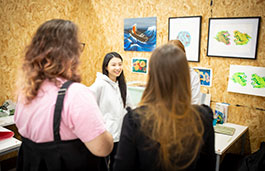Search
Graphic Design BA (Hons)
Study level: Undergraduate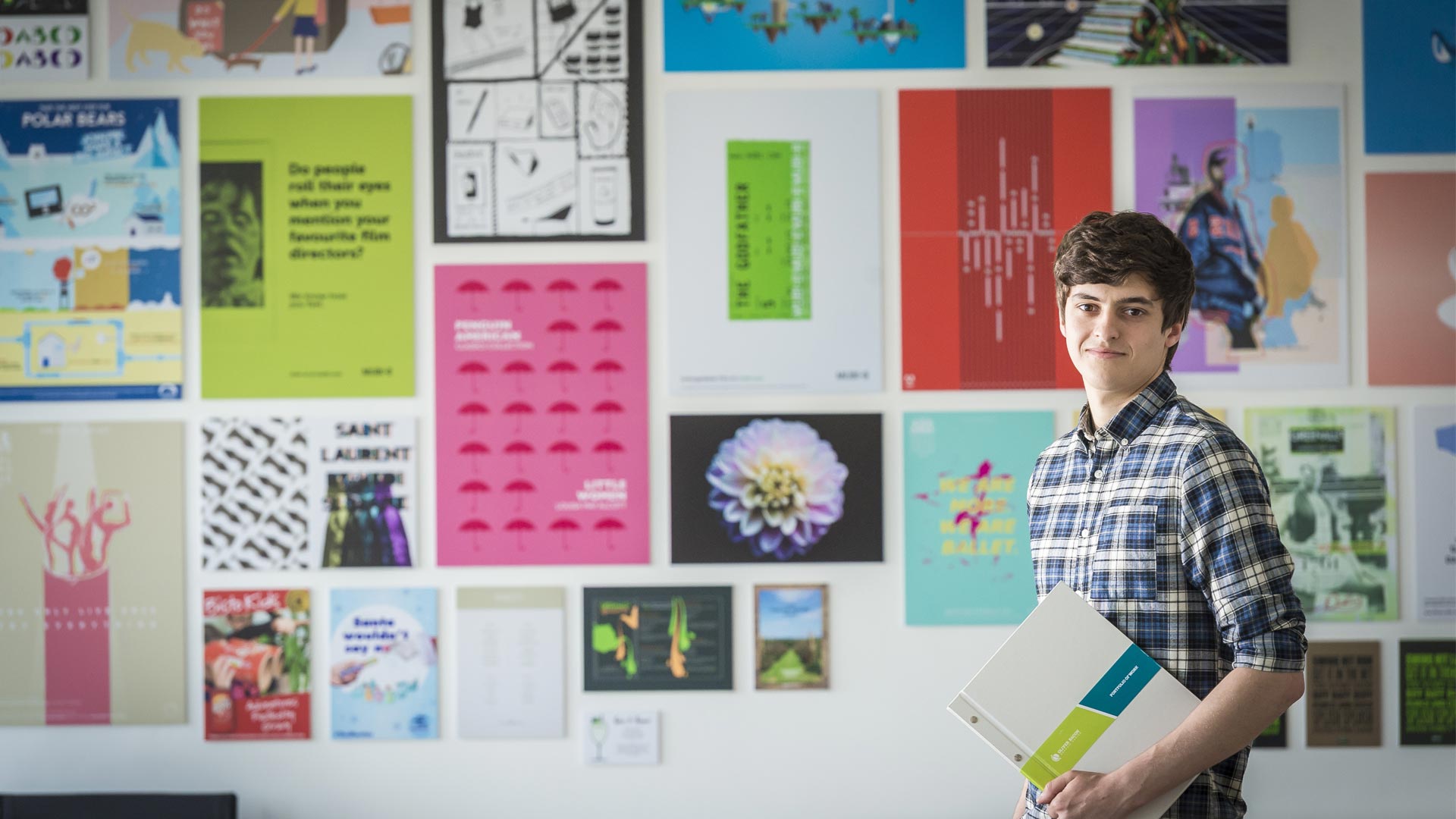
The future graphic designer is visionary, informed, responsible and technically adaptable. Coventry University’s Graphic Design BA (Hons) course challenges and guides you to become just that.
Year of entry
Location
Coventry University (Coventry)
Study mode
Full-time
Sandwich
Duration
3 years full-time
4 years sandwich
Course code
W211
Start date
September 2025
Course overview
The course aims to get you industry-ready, whether that means joining a design business or starting up your own. During the course, you should develop an all-round grasp of graphic design and a bespoke portfolio of work that suits your personal career aspirations.
The course aims to offer you:
- A comprehensive design foundation: you will be equipped with key design principles and experience across a range of design contexts. Through an intensive exploration of today’s vast graphic design landscape and crucial design principles you’ll delve into branding, advertising, information design, editorial and web design, type design, motion graphics and UI/ UX design.
- Creative ownership: you will be empowered to take control of your own learning. Through select modules you will get to choose your own briefs, practice skills you’re passionate about and formulate your own views on design.
- Expand your portfolio: your aim will be to develop a strong portfolio of work, and proactively define and pursue your own interests and long-term goals.
Rated Gold Overall
Teaching Excellence Framework (TEF) 20235 QS Stars for Teaching and Facilities
QS Stars University RatingsTop 5 Student City in England (Coventry)
QS Best Student Cities Index 2025Why you should study this course
Graphic designers harness the power of visual language to shape our perceptions of the world. Graphic Design at Coventry University isn’t just about making ‘pretty pictures. Instead, the course enables you to practice graphic design as a means of making meaningful contributions to the world. Here is how:
- Exploration: the course fosters ways of working that encourage creative discovery. Play and experimentation with analogue and digital mediums, methods and techniques is embedded in all modules. The course is attuned to industry standards, but it does not aim to replicate the working world; instead, it provides a safe space for innovation and uninhibited imagination.
- Employability: the course should prepare you to be a productive force within industry. The course aims to provide you with key professional skills by working on authentic design briefs, with real clients, taking part in studio visits and portfolio reviews, attending guest and alumni talks and showcasing your work through participation in renowned competitions such as D&AD2.
- Technical Skill: the course wants you to take pride in the work that you make. Attention to detail and industry standard designs are developed through practiced skill and iteration. Craftsmanship is considered just as important as a clever idea.
- Critical Thinking: the course believes that an inquisitive and investigative mindset leads to original designs. You will learn to gather data, ask questions and draw conclusions to justify design decisions. In a world of questionable news and misinformation, an informed, inquisitive designer can begin to make a change in local, national and global communities.
- Storytelling: the course channels the power of design to connect and engage with people. Not only will you use design to solve problems, but also through storytelling methods you will also access design's ability to enchant and activate emotions.
for Career Prospects in Graphic Design in the UK
The Guardian University Guide 2024
Art and Design Graduate Showcase 2024
The Coventry Degree Showcase is an annual event to celebrate and showcase our graduating students’ work.
What you'll study
This course has a common first year.
The common first year enables you to work alongside students doing similar courses to you, to widen your knowledge and exposure to other subject areas and professions. You will have the opportunity to collaborate with other students, so you can share your insights and experience which will help you to develop and learn.
If you discover an interest in a specific subject you have studied, upon successful completion of your first year, you could swap degrees with another course in your common first year (subject to meeting progression requirements).
Common first year courses:
- Automotive and Transport Design BA (Hons)
- Graphic Design BA (Hons)
- Product Design BA (Hons)
We regularly review our course content, to make it relevant and current for the benefit of our students. For these reasons, course modules may be updated.
How you'll learn
The course prides itself on a holistic approach, which exposes you to a wide range of graphic design contexts and outputs. You will experiment and practice with materials, methods and technologies as you learn about the creation, production and distribution of design work.
Theory, research and critical enquiry are seen as integral to the design process and will guide the development of work on most modules. Technical skills instruction sessions introduce you to fundamental practical and software tools, including the Adobe suite. The course encourages play and whilst it has employability at its core it does not aim to fully replicate the industry environment, making space for creative exploration and the uninhibited investigation of ideas that could pave the way to future innovation.
You will achieve increasing levels of control over what you make and how you make it as your confidence and creative voice becomes more established during your Coventry University Graphic Design journey.
This course is taught through a combination of lectures, tutorials, seminars and workshops. The course is not prescriptive, instead it proposes lines of inquiry which you are encouraged to engage with and study outside of class.
Teaching contact hours
As a full-time undergraduate student, you will study modules totalling 120 credits each academic year. A typical 20 credit module requires a total of 200 hours study. This is made up of teaching contact hours, guided and independent study.
Teaching hours:
Teaching hours vary each semester, year of study and due to module selection. During your first year you can expect 15-18 teaching hours each week. You will also have the option to attend optional sessions including time with a progress coach or to meet with staff for advice and feedback. As you progress through your studies, teaching hours may reduce.
Guided and independent study:
Throughout your studies, you will be expected to spend time in guided and independent study to make up the required study hours per module. You’ll be digging deeper into topics, review what you’ve learned and complete assignments. This can be completed around your personal commitments. As you progress through your studies, you’ll spend more time in independent study.
Online learning:
As an innovative university, we use different teaching methods including online tools and emerging technologies. So, some of your teaching hours and assessments may be delivered online.
Assessment
This course is assessed using a variety of methods that recognise module-specific skills and learning. You are predominantly assessed by coursework and assessment methods prepare you for the diverse contexts in which your design work may exist.
Assessment methods may include:
- practical coursework
- digital coursework
- individual work
- group work
- live presentations
- video presentations
- video essays
- academic essays.
The Coventry University assessment strategy aims to ensure that our courses are fairly assessed and allows us to monitor student progression towards achieving the intended learning outcomes.
International experience opportunities
Throughout the course, graphic design projects are set with an international focus, enhancing your global experience and broadening your mindset. Students will also engage in Collaborative Online International Learning (COIL) projects with partner institutions and other international universities around the world2.
Please note that all international experience opportunities may be subject to additional costs, competitive application, availability, and meeting applicable visa and travel requirements, and are therefore not guaranteed2.
Community is what makes this course special. Whether we’re preparing students to join professional networks, going above and beyond to nurture creative mindsets in the studio or forging cross-disciplinary relationships, community is at the heart of what we do. We don’t just simply say so, our students have said so by voting us Course of the Year at the Student Voice Awards 2024.
Paula Murarescu, Course Director (2024)

Entry requirements
Typical entry requirements:
Fees and funding
| Student | Full-time | Part-time |
|---|---|---|
| UK, Ireland*, Channel Islands or Isle of Man | £9,535 per year | Not available |
| EU | £9,535 per year with EU Support Bursary** £19,850 per year without EU Support Bursary** |
Not available |
| International | £19,850 per year | Not available |
If you choose to study this course with a professional placement2 or study abroad year, you will need to pay a tuition fee3 to cover your academic support throughout your placement year. Students commencing their professional placement in the academic year 2027/28 will pay £1,500 if they are paying UK fees, or £1,800 if they are paying international fees.
For advice and guidance on tuition fees and student loans visit our Undergraduate Finance page and see The University’s Tuition Fee and Refund Terms and Conditions.
The University will charge the tuition fees that are stated in the above table for the first Academic Year of study. The University will review tuition fees each year. For UK (home) students, if Parliament permits an increase in tuition fees, the university may increase fees for each subsequent year of study in line with any such changes. Note that any increase is expected to be in line with inflation.
If you choose to study this course with a professional placement, the University will charge the tuition fees stated above for those on a placement during Academic Year 2027/28. The University will review professional placement tuition fees each year. For UK (home) students, the University may increase fees for each subsequent year of study, but such that it will be no more than 5% above inflation.
For international students, we may increase fees each year, but such increases will be no more than 5% above inflation. If you defer your course start date or have to extend your studies beyond the normal duration of the course (e.g. to repeat a year or resit examinations) the University reserves the right to charge you fees at a higher rate and/or in accordance with any legislative changes during the additional period of study.
We offer a range of International scholarships to students all over the world. For more information, visit our International Scholarships page.
Tuition fees cover the cost of your teaching, assessments, facilities and support services. There may be additional costs not covered by this fee such as accommodation and living costs, recommended reading books, stationery, printing and re-assessments should you need them. Find out what's included in your tuition costs.
The following are additional costs not included in the tuition fees:
- Any optional overseas field trips or visits: £400+ per trip.
- Any costs associated with securing, attending or completing a placement (whether in the UK or abroad).
*Irish student fees
The rights of Irish residents to study in the UK are preserved under the Common Travel Area arrangement. If you are an Irish student and meet the residency criteria, you can study in England, pay the same level of tuition fees as English students and utilise the Tuition Fee Loan.
**EU Support Bursary
Following the UK's exit from the European Union, we are offering financial support to all eligible EU students who wish to study an undergraduate or a postgraduate degree with us full-time. This bursary will be used to offset the cost of your tuition fees to bring them in line with that of UK students. Students studying a degree with a foundation year with us are not eligible for the bursary.
Facilities
The Delia Derbyshire building provides you with a range of facilities you can use to enhance your skills through practical applications. You will have the opportunity to work both independently and collaboratively while using a hyper studio designed for cross-disciplinary projects; immersive studios with cutting-edge virtual reality and mixed-reality technologies4.
Our current digital and industrial workshops are of industry-standard quality and house 3D rapid prototyping, laser cutters and milling machines. These facilities are available to all students on our courses at no extra cost. These are subject to availability.
We also have a ceramic and small-metal-working workshop, a large digital print bureau, and clay modelling studios where you can realise your creative artistic and design solutions.
The fashion workshops have digital embroidery machines, digital printers and a printmaking workshop that includes etching, screen printing and a rare, one of only three in existence in the UK, letterpress studio.
In our Mac and PC CAD labs, you can become digitally literate in presentation and design skills using the Adobe suite of software. You can also learn other software packages including Alias, Toom Boom, Revit, and Maya that maybe relevant to your studies.
Facilities are subject to availability. Access to some facilities (including some teaching and learning spaces) may vary from those advertised and/or may have reduced availability or restrictions where the university is following public authority guidance, decisions or orders.
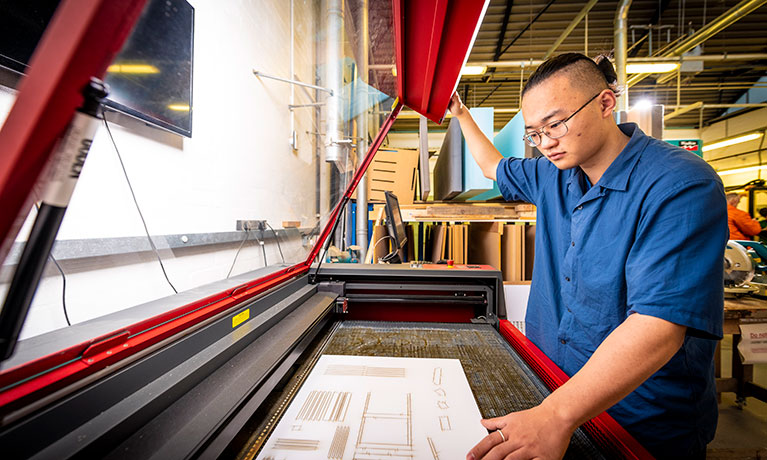
Print-making workshops
Our print-making space features silk-screen printing, relief printing and etching facilities that you can use to generate artwork for your graphic design projects. (Location: Delia Derbyshire Building)

Letterpress workshop
Our letterpress workshop provides the opportunity to typeset using authentic metal and wooden type, and print your text on an original handpress.
(Location: Delia Derbyshire Building).
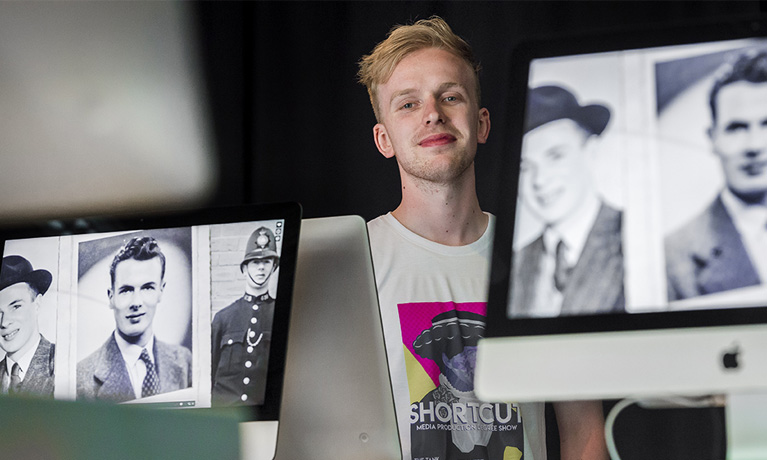
Software suites
Our studios are equipped with the latest Adobe software, meaning you have cutting-edge digital tools with which to design print or multimedia products. (Location: Delia Derbyshire Building).
Careers and opportunities
The structure of the course, the experiences and support made available to you are all designed with a view to developing the skills, competencies and imaginative thinking necessary for a creative career in a demanding, competitive and rapidly changing work environment.
Whether you choose to enter employment in a design agency or studio upon graduation, or have dreams of becoming self-employed, the course aims to produce graduates that are flexible, responsive and resilient. Whatever your career trajectory, we work together to make you industry ready.
The university's Talent Team is on hand to offer tailored career and enterprise support if you wish to gain employment or take advantage of professional practice opportunities within course specific industries. It aims to provide specialist careers information, advice and guidance to all our students from their first year through to final year and beyond graduation, helping them receive the opportunities to reach their desired career outcome.
Our Graphic Design students have previously won reputable design competitions such as D&AD and the Penguin Cover Design Award, and they received many YCN commendations. Our graduates have gone on to create award winning advertising campaigns for Silver Spoon and moving imagine work for The Mill, user interfaces for IBM, marketing work for premier UK football teams, and campaign touchpoints for Vintage Books’ release of Kamala Harris’ New York Times bestselling book 'The Truths We Hold'.
Where our graduates work
- Arsenal
- New Genre
- IBM
- Springetts
- Scholastic
- Tata Motors
- Havas Lynx Group
- BOND Agency
- Exient
- FutureDeluxe
- Kaizen
- Rebel Creatives
- Sky TV
- Simon & Schuster
- The Football Association
- THG
- Tottenham Hotspur Football Club
- Whiteroom Agency
Our graduates have also produced freelance work for organisations including MTV, Natwest, Xbox, Nike, HEAD, BBC, Channel 4, Sports Relief and Children in Need.
Further study
- Advertising and Marketing MA
- Brand Management MA
- Design Management MA
- Digital Marketing Management MSc
- Graphic Design MA
- Illustration and Animation MA
- International Marketing Management MSc
You may be entitled to an alumni discount on your fees if you decide to extend your time with us by progressing from undergraduate to postgraduate study.
The course allowed me to gain both practical and theoretical knowledge that I can take into the future. It helped me gain confidence in my design work and enabled me to work alongside different studios in London and Liverpool to gain real experiences and network in the community. In addition, the lecturers were really helpful and encouraged me to produce my best work that allowed me to graduate from the course with a strong portfolio.
Rhiannon Young (Graphic Design graduate, 2021)
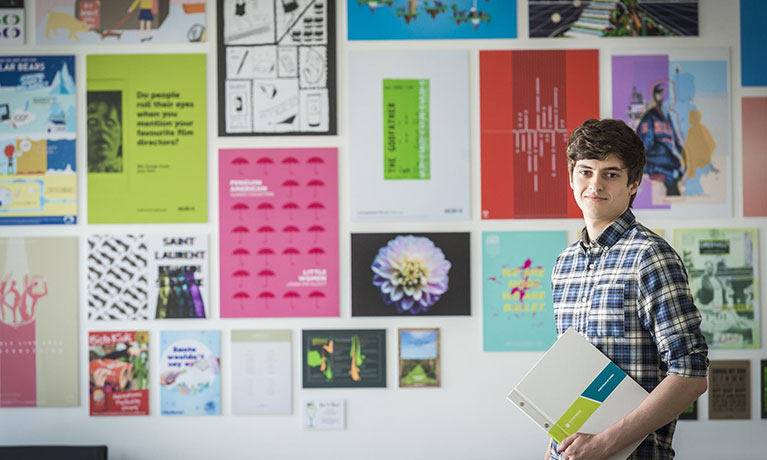

Discover Phoenix+
Phoenix+ brings you together with other students to learn, experience and develop essential knowledge and skills. Whatever destination you choose, it's about preparing you for life after university.
Learn more about Phoenix+How to apply
You may also like
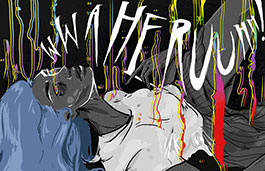
Illustration BA (Hons)
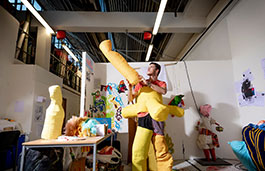
Fine Art BA (Hons)

